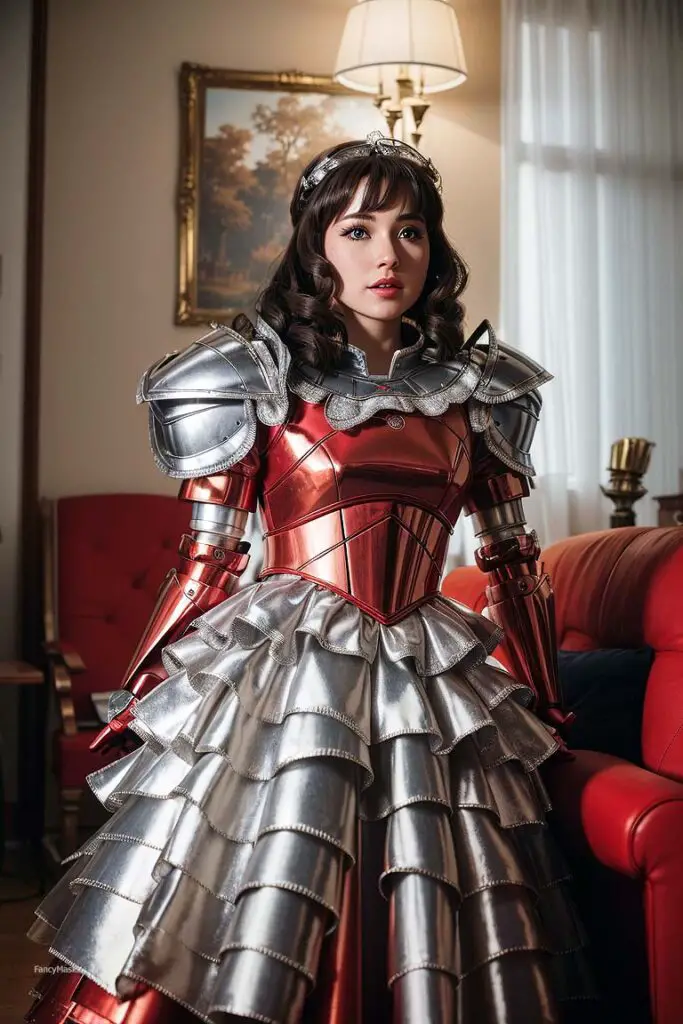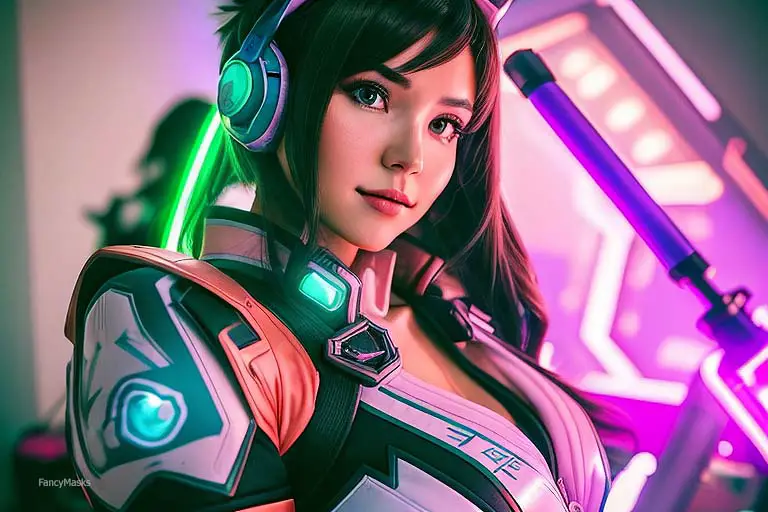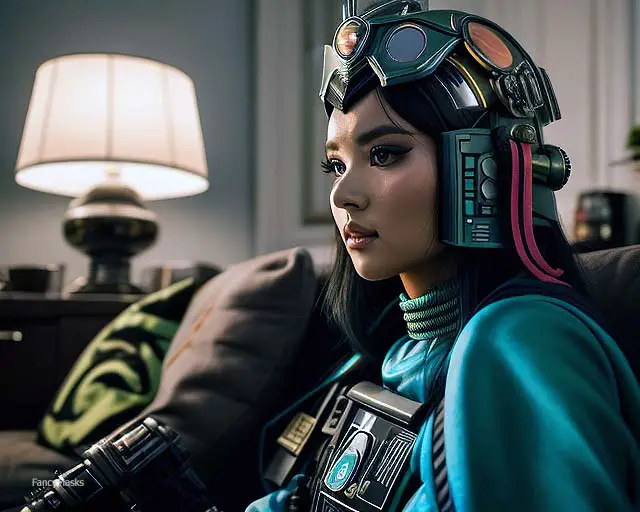Articulating joints play a crucial role in bringing cosplay armor to life, adding functionality and mobility to your costume. These joints allow for fluid movement and flexibility, enabling cosplayers to embody their favorite characters with ease.
Whether you’re constructing articulated gauntlets, leg armor, or even a full-body suit, understanding the importance of articulating joints is fundamental to creating an impressive cosplay ensemble. When it comes to constructing articulating joints in cosplay armor, you need to consider various factors such as materials, joint mechanics, and design aesthetics.
One of the first things to ponder is the type of cosplay armor you want to create. Are you aiming for a sleek futuristic look or a rugged medieval appearance? Do you want to learn how ot make articulating joints in cosplay armor?
Understanding your desired final aesthetic will guide your decisions throughout the construction process. The materials chosen for your cosplay armor play an essential role in determining the effectiveness of articulating joints.

Lightweight yet durable materials are highly recommended since they allow for comfortable movement without sacrificing stability. Commonly used materials include EVA foam, thermoplastics like Worbla or Wonderflex, and craft foam.
These can be easily shaped and manipulated into intricate joint mechanisms while still maintaining an authentic appearance. To ensure successful construction of articulating joints in cosplay armor, having a blueprint or design plan is crucial.
This blueprint acts as your guide throughout the process and helps maintain consistency in measurements and proportions across different sections of the costume. By carefully mapping out where each joint will be placed and how it will function within its respective piece of armor, you can ensure that all components work together harmoniously.
Constructing articulating joints is an integral part of creating impressive cosplay armor that not only looks great but also allows for freedom of movement during conventions or photoshoots. By considering factors such as material choice, joint mechanics, and design aesthetics while following a blueprint for consistency and accuracy across your costume pieces, you’ll be well on your way to crafting exceptional articulating joints that enhance the overall appeal of your cosplay armor.
Necessary Materials and Tools for Articulating Joints
When it comes to creating articulating joints in cosplay armor, having the right materials and tools is crucial. These will not only help you achieve the desired level of mobility and flexibility but also ensure the durability and longevity of your armor.
So let’s dive into the necessary materials and tools for constructing these intricate joints. Firstly, let’s talk about the materials.
One of the most commonly used materials for articulating joints in cosplay armor is EVA foam or craft foam. This lightweight and flexible material is ideal for creating movable parts while maintaining a comfortable fit.
Additionally, Worbla, a thermoplastic material, can be used to reinforce certain areas or add extra details to your joints. For attaching the joints together, you’ll need some fasteners like Chicago screws or rivets.
These provide a secure connection while allowing for easy disassembly if needed during repairs or modifications. Velcro straps can also come in handy when designing adjustable joints that can be tightened or loosened as required.
Now let’s move on to the tools you’ll need for this project:
- Heat Gun
- Hot Glue Gun
- Utility Knife (with extra blades)
- Dremel Tool
- Ruler or measuring tape
- Fabric Scissors
- Gloves
- Safety Goggles

Planning and Designing Your Articulating Joints
When it comes to planning and designing articulating joints for your cosplay armor, taking the time to carefully strategize and create a blueprint is crucial. Articulating joints in costume design require thoughtful consideration to ensure both functionality and aesthetics.
Here are some key aspects to keep in mind during the planning phase. Firstly, you need to determine the range of motion you want your articulating joints to achieve.
Consider the character you are cosplaying as well as their movements and poses. Study reference images or videos of the character in action, paying attention to how their joints move.
This will help you visualize how your own articulating joints should function. Next, think about the materials you will be using for your cosplay armor.
Different materials offer varying degrees of flexibility and durability, which can greatly affect how well your articulating joints work. Lightweight but sturdy options such as Worbla or EVA foam are commonly used for DIY cosplay armor, while more advanced techniques may involve metal components like hinges or ball bearings.
Furthermore, consider how the size and weight of your cosplay armor will impact joint mobility. Heavier armor pieces may require stronger joint mechanisms or additional support structures to ensure they can move freely without excessive strain.
Take into account any potential balance issues that might arise when wearing your cosplay armor with articulating joints. By thoroughly considering these factors during the planning and design phase, you’ll be able to create a detailed blueprint for your cosplay joints that addresses functionality, material choices, and potential challenges associated with mobility.
Once this blueprint is established, you’ll be well-prepared for constructing articulate joints that bring life and movement to your cosplay armor creation. Remember that in constructing articulate joints for cosplay armor it is essential not only to prioritize functionality but also take into account aesthetic aspects like finishing techniques in cosplay armor mentioned later on this article’s sections
Choosing Your Joint Mechanism
When it comes to choosing the right joint mechanism for your cosplay armor, you have a variety of options to consider. The joint mechanism is what allows your armor pieces to move and articulate, giving you the flexibility and range of motion needed to bring your character to life. Custom Cosplay Creation is all about personalization, so it’s important to select a mechanism that suits both the design and functionality of your costume.
One popular choice for joint mechanisms in cosplay armor is using ball joints. These versatile joints consist of a ball-shaped end that fits into a socket, allowing for smooth rotation and movement.
Ball joints are commonly used in various industries due to their durability and ability to bear weight. When incorporated into cosplay armor, they provide stability while allowing for easy movement in multiple directions.
Storing Cosplay Armor becomes more manageable with well-designed ball joints that can be disassembled when needed. Another option worth considering is hinge joints.
These types of joints function similarly to door hinges, enabling movement along one axis or plane. Hinge mechanisms are ideal for specific parts of the costume where bending or folding at specific angles is required, such as elbows or knees.
When used correctly with appropriate Tools for Armor Making, hinge joints can provide reliable movement without compromising stability. If you’re aiming for complex movements and more advanced articulation in your cosplay armor, cable-based systems might be the way to go.
Cable systems use cables or wires connected to various points on the costume piece and allow controlled motion through tensioning or loosening those cables. This method works well for intricate designs that require synchronization between different parts of the costume.
While constructing Articulating Joints with cable-based systems may be more time-consuming compared to other methods, it offers unparalleled mobility and flexibility in your finished DIY Cosplay Armor. Remember, when selecting your joint mechanism, it’s essential to consider factors such as ease of construction during Cosplay Armor Assembly, compatibility with chosen materials, and the overall design aesthetic.
By carefully weighing your options and considering the requirements of your Cosplay Armor Design, you can choose a joint mechanism that ensures both functionality and visual appeal. In the next section, we will delve into the construction process of Articulating Joints, where we will explore how to bring your chosen mechanism to life in your cosplay armor blueprint.
The Construction Process of Articulating Joints
Once you have your blueprint for cosplay joints ready, it’s time to dive into the construction process. This is where your vision starts to come to life! Before you get started, ensure that you have all the necessary tools and materials at hand.
This may include a heat gun, EVA foam sheets, a utility knife, contact cement, and various fasteners like snaps or Velcro. Having these items readily available will make the construction process much smoother.
To begin constructing articulating joints, start by cutting out the desired shapes from your EVA foam sheets. Make sure to measure and mark the pieces accurately according to your design plan.
Once cut out, use a heat gun to shape and mold the foam into the desired contours for optimal mobility and fit. Next, it’s time to attach the individual pieces together using contact cement or other adhesive options suitable for EVA foam.
Apply an even layer of adhesive to both surfaces that need bonding and wait until it becomes tacky before pressing them firmly together. Remember that good craftsmanship is crucial here – take your time in aligning and joining each piece carefully.
After assembling the joints, it’s important to test their functionality before moving forward with any additional steps. Attach them temporarily onto your cosplay armor using temporary fasteners such as binder clips or safety pins.
Put on your armor and test its mobility by moving different body parts like arms or legs in a realistic range of motion. This will allow you to identify any issues with fit or movement early on.
Remember when constructing articulating joints for cosplay armor that attention to detail is key; this will ensure not only durability but also enhance overall appearance and functionality in your custom creation. Take pride in each joint that you assemble because every joint matters!
Testing and Making Adjustments to Your Articulating Joints
Once you have constructed the articulating joints for your cosplay armor, it’s time to put them to the test and make any necessary adjustments. Testing your joints is crucial to ensure that they provide the desired range of motion and stability.
To begin, put on your cosplay armor and move around in it, mimicking the actions you intend to perform while wearing it. This could include bending, kneeling, or raising your arms.
Take note of any restrictions in movement or areas where the joints feel too loose or tight. If a joint is too stiff, you may need to sand down certain parts or apply lubrication to improve its mobility.
On the other hand, if a joint is too loose and fails to hold its position securely, adding additional padding or tightening screws might be necessary. Troubleshooting articulating joints requires a keen eye for detail and patience.
If you notice any parts rubbing against each other excessively or getting caught on surrounding pieces of armor, it’s important to identify these problem areas before making adjustments. Consider using small additions like foam padding or strategically placed fabric to prevent friction between moving components.
In some cases, you might realize that an entire joint mechanism needs redesigning. Don’t get discouraged; this is part of the creative process!
Take some time to evaluate why a particular joint isn’t functioning as intended and consult your blueprint for reference. Keep in mind that DIY cosplay armor requires experimentation and problem-solving skills – always be open to making changes that will improve your overall costume design.
With thorough testing and careful adjustments made along the way, you can ensure that your articulating joints provide optimal mobility without compromising stability. Remember that constructing custom cosplay armor involves both creativity and practicality – finding the right balance will make all the difference when it comes to bringing your character to life!
Keep reading for tips on applying finishing techniques and maintaining your cosplay armor properly. (Mentioned phrases: Cosplay Armor Materials, Testing Cosplay Armor Mobility, Joint Mechanics in Cosplay, Troubleshooting Articulating Joints, DIY Cosplay Armor, Blueprint for Cosplay Joints)
Applying Finishing Touches to Your Articulating Joints
When it comes to creating articulating joints for your cosplay armor, applying the finishing touches is a crucial step that adds both functionality and visual appeal to your creation. After all, you don’t want your joints to stand out like a sore thumb amidst your carefully crafted armor. So, let’s dive into some techniques and considerations for applying those essential finishing touches.
One of the first things you can do is to sand down any rough edges or imperfections on the joints. This will not only ensure a smooth finish but also reduce any friction that might hinder the joint’s mobility.
Use fine-grit sandpaper and gentle circular motions to achieve the desired result. Be attentive around areas where the joint connects with other components of your cosplay armor, as you want everything to fit seamlessly together.
Next, you can apply a primer or base coat to your articulating joints. Choose a primer that adheres well to the materials used in your cosplay armor construction, such as foam or thermoplastics.
The primer will create a consistent surface for paint application while also enhancing durability. Consider using primers specifically designed for flexibility and weather resistance if you plan on wearing your cosplay at outdoor events or conventions.
Now it’s time for painting! This is where you can get creative with colors and finishes that complement your overall costume design.
You can use techniques such as dry brushing or airbrushing to add depth and texture to your joints. Experiment with metallic paints if you want an authentic metallic look or opt for weathering techniques like rust effects if you’re going for an aged appearance.
Just be sure that the paint doesn’t impede joint movement by applying thin layers and allowing sufficient drying time between coats. Remember, the finishing touches are what truly bring your articulating joints in cosplay armor to life – so take this opportunity to showcase your creative flair while ensuring their functionality within your overall costume design!
Maintenance and Care for Your Articulating Joints
When it comes to maintaining and caring for your articulating joints in cosplay armor, there are a few important things to keep in mind. Proper maintenance ensures that your joints continue to function smoothly and serve their intended purpose throughout the life of your cosplay costume. Here are some tips to help you take care of your articulating joints:
First and foremost, regular inspection is crucial. Before and after each use, take the time to carefully examine your articulating joints.
Look for any signs of wear or damage such as cracks, looseness, or misalignment. If you notice any issues, it’s essential to address them promptly before they worsen.
This can involve tightening screws, replacing worn-out parts, or making necessary adjustments. Cleaning your articulating joints is another important aspect of maintenance.
Over time, dirt and debris can accumulate in the crevices of the joints, hindering their movement and causing unnecessary strain on the mechanism. To clean them effectively, use a soft brush or a cloth along with a mild detergent or soapy water solution.
Be gentle while cleaning to avoid damaging any delicate parts. Additionally, lubrication plays a vital role in keeping your articulating joints functioning smoothly.
Applying an appropriate lubricant will help reduce friction between moving parts and minimize wear over time. Be sure to choose a lubricant that is compatible with the materials used in your joint mechanism; consult the manufacturer’s instructions if available.
By incorporating these maintenance practices into your routine, you can ensure that your articulating joints remain in optimal condition for longer-lasting functionality and enjoyment of your cosplay armor ensemble. Remember: proper care extends beyond just maintaining individual pieces—it’s equally essential to store your cosplay armor properly when not in use.
Consider investing in a dedicated storage solution like a padded case or garment bag specifically designed for cosplay costumes. This will protect both the overall structure of the armor as well as its intricate articulating joint mechanisms from potential damage caused by mishandling or exposure to environmental factors.
Maintaining and caring for your articulating joints in cosplay armor is crucial to their longevity and functionality. Regular inspection, cleaning, lubrication, and proper storage are key aspects of effective maintenance.
By diligently following these practices, you can ensure that your articulating joints continue to provide the desired range of motion and enhance the overall appeal of your cosplay armor for years to come. So take the time to give your articulating joints the attention they deserve—your future self at conventions will thank you!
Articulating Joints and Cosplay Armor: Putting It All Together
Now that you have successfully constructed your articulating joints and completed the various components of your cosplay armor, it’s time to put it all together. This stage is where your hard work pays off and you can truly see your vision come to life. By following these steps, you’ll ensure that your articulating joints function smoothly and seamlessly within the overall design of your cosplay armor.
Start by laying out all the pieces of your cosplay armor, including the sections with articulating joints. Take a moment to review your blueprint for cosplay joints and refer back to your initial design plans to make sure everything aligns as intended.
This will prevent any surprises or setbacks during assembly. Next, begin attaching the pieces together using the appropriate tools for armor making.
Depending on the materials used for construction, this may involve fasteners such as screws or rivets, or it may require adhesive bonding techniques for a more seamless appearance. It’s essential to follow instructions carefully and take note of any specific recommendations based on the cosplayer’s experience with similar joint mechanics in cosplay projects.
As you progress with the assembly, don’t forget to test the mobility of each joint. Move each joint in all directions to ensure they function properly without any restrictions or binding.
This step is crucial because even minor misalignments can hinder movement and affect both comfort and visual appeal. Once all pieces are securely attached and fully functional, it’s time for finishing touches in cosplay armor construction.
Use appropriate techniques to blend seams or cover fasteners so that they are discreetly incorporated into the overall design. Whether painting, weathering, or applying other finishing techniques in cosplay armor creation, make sure everything is cohesive aesthetically.
Remember that while constructing articulating joints is an important aspect of costume design engineering and custom cosplay creation, proper maintenance is equally vital. Regularly check screws or fasteners for tightness and address any signs of wear or damage promptly.
Additionally, research methods for storing cosplay armor to maintain its structural integrity and prevent undue stress on the articulating joints. By putting all these steps together, you can achieve a final result that not only showcases your craftsmanship but also enhances the functionality and mobility of your cosplay armor.
The attention to detail in constructing articulating joints will set your costume apart and contribute to an overall impressive portrayal of your character. So, go ahead and proudly wear your masterpiece – you’ve earned it!

Preserving Your Cosplay Armor and Its Articulating Joints
When it comes to preserving your hard-earned cosplay armor and its intricate articulating joints, a little extra care goes a long way. After putting in all that effort to create your custom cosplay creation, it’s essential to ensure that it remains in pristine condition for future use.
Here are some tips on how to preserve your cosplay armor and its articulating joints. Firstly, storing your cosplay armor properly is crucial for maintaining its integrity.
Make sure you have a designated space to keep it safe when not in use. Ideally, find a cool and dry area away from direct sunlight, which can cause fading and damage to the materials used in your cosplay armor.
Consider investing in storage solutions such as garment bags or plastic containers designed specifically for these types of costumes. This will protect them from dust, moisture, and potential damage from accidental bumps or falls.
Next, regular maintenance is key to preserving the functionality of your articulating joints. Ensure that all screws, bolts, or fasteners are secure and tightened appropriately before each use.
Inspect the joint mechanics carefully for any signs of wear or damage after each wear or convention appearance. If you notice anything amiss, address it promptly by replacing worn-out components or making necessary repairs with the right tools for armor making.
Consider applying some finishing techniques to protect the surface of your cosplay armor while adding an extra layer of authenticity. Depending on the materials used in its construction – whether foam, thermoplastics like Worbla or EVA foam – you can apply protective coatings such as sealants or clear varnishes suitable for those specific materials.
These coatings will not only safeguard against scratches but also increase longevity by minimizing wear caused by repeated use. Taking proper care of your cosplay armor and its articulating joints is crucial if you want them to last beyond one convention season.
By storing them correctly when not in use, performing regular maintenance checks, and applying appropriate finishing techniques, you can ensure that your hard work and dedication pay off in the form of a well-preserved cosplay masterpiece. So, grab your tools for armor making and start preserving your cosplay armor today!
Wrapping Up: The Importance of Articulating Joints in Cosplay Armor
When it comes to creating a truly remarkable cosplay armor, the importance of articulating joints cannot be overstated. These joints play a crucial role in allowing you to move freely and comfortably while wearing your armor, bringing your character to life with every step.
Without well-designed and properly constructed articulating joints, even the most visually stunning cosplay armor could become little more than a beautiful but immovable statue. Testing Cosplay Armor Mobility is essential for any cosplayer who wants to embody their character fully.
Articulating joints enable fluid movements, allowing you to strike dynamic poses and engage in action-packed scenes with ease. Imagine attending a convention or participating in a cosplay contest where you’re restricted by stiff, non-articulated armor—it would be like trying to dance with concrete shoes!
With well-crafted articulating joints, however, your movements become graceful and natural, capturing the essence of your character’s agility and power. Constructing Articulating Joints requires precision and attention to detail.
From selecting the right joint mechanics for your specific design to ensuring that all components fit together seamlessly, every step is crucial. By incorporating these custom-made joints into your DIY Cosplay Armor creation process, you are not only elevating its functionality but also guaranteeing that it will withstand the demands of prolonged wear and tear.
Moreover, unlike static costumes that restrict movement entirely or limit it severely, cosplay armor featuring articulating joints provides an exhilarating experience both for the wearer and those admiring their creative prowess. Maintenance is a vital aspect of preserving the durability and effectiveness of your cosplay armor’s articulating joints.
Regularly inspecting each joint mechanism for signs of wear or damage ensures that they continue functioning optimally over time. Additionally, applying Finishing Techniques in Cosplay Armor construction can help protect these components from rust or corrosion while enhancing their appearance.
Proper storage techniques, such as using padded boxes or garment bags, also safeguard the joints from potential damage during transportation or when not in use. By prioritizing these maintenance practices, you can extend the lifespan of your cosplay armor’s articulating joints and continue to dazzle audiences with your impeccable craftsmanship.
Articulating joints are the backbone of any successful cosplay armor design. They enable mobility and flexibility, allowing you to embody your character authentically and captivatingly.
Through careful testing, meticulous construction, regular maintenance, and proper storage techniques, you can ensure that these essential components serve their purpose effectively for years to come. So go forth with confidence in your ability to construct remarkable cosplay armor that not only looks visually stunning but also moves with grace and functionality thanks to its well-crafted articulating joints!
Conclusion
The art of creating articulating joints in cosplay armor is a challenging yet incredibly rewarding endeavor. Through this process, you not only enhance the mobility and functionality of your cosplay armor but also bring your character to life in a way that surpasses expectations. From meticulously planning and designing your joints to constructing them with precision, every step contributes to the overall success of your cosplay project.
However, the journey does not end once your articulating joints are complete. It is essential to maintain and care for your cosplay armor and its joints properly.
Regular inspections and maintenance routines will help ensure their longevity. Additionally, investing in a suitable storage solution that protects the integrity of the articulating joints will prevent any accidental damage when not in use.
Remember that constructing articulating joints requires patience, practice, and attention to detail. If you encounter any challenges along the way, don’t be discouraged!
Troubleshooting and testing mobility are crucial steps towards achieving optimal joint functionality. By exploring various joint mechanisms and mastering their construction techniques, you open up endless possibilities for future custom cosplay creations.
The knowledge gained from this process can be applied to other costume designs as well. So go forth with confidence, armed with a blueprint for successful articulating joints!
In essence, crafting articulating joints in cosplay armor elevates your costume from static beauty to functional masterpiece. Embrace this art form with passion and perseverance; let it carry you into a world where imagination knows no bounds.
Let your creations inspire others as they marvel at both their aesthetic appeal and impressive mobility. Remember: Cosplay Armor Assembly is more than just putting pieces together; it’s an expression of creativity realized through meticulous craftsmanship!




